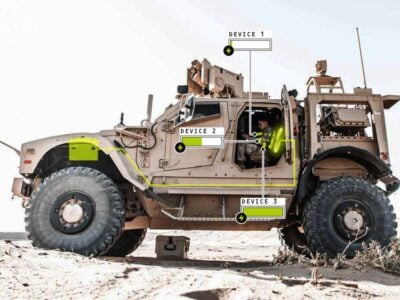
8 Gigabit data connection to aircraft successfully tested
The researchers achieved the data rate of 8 GB/s by using the frequency range between 71 and 76 GHz for an air-to-ground radio link. In this frequency range, large bandwidths are available to achieve multi-gigabit data rates, and this frequency band has recently been released by the authorities for such purposes. With the technology developed, both broadband Internet and video-on-demand could be available in passenger aircraft in the future. Or high-resolution videos or sensor data from an aircraft, an earth observation satellite or a drone could also be transmitted continuously and uncompressed to the ground.
“The frequencies now available offer a good compromise between possible data rate and susceptibility to interference,” says Thomas Zwick, head of the Institute of Radio Frequency Technology and Electronics at KIT. The data rate achieved enables the simultaneous transmission of up to 600 different video streams in high-resolution 4K quality. Global satellite networks that are seamlessly integrated into fiber optic and wireless networks on the ground using this technology can provide globally available broadband Internet and ensure data-hungry services on the Internet of Things. In the same way, the constantly growing amounts of data from the operation of the aircraft can be read out of the on-board memory in an extremely short time during approach or overflight. Until now, this has been done by cable, while the aircraft is standing on the tarmac, which costs time and therefore makes the innovation particularly interesting for airlines.
During the test flights, the research aircraft circled around the receiving station at an altitude of 1,000 meters within a radius of 5 to 12 kilometers. However, the receiving station was not in orbit in a satellite, but on the ground.
This shows that the technology is still a long way from being introduced commercially on intercontinental flights. For the start, the scientists tested the stability of the broadband connection over relatively short distances. After all, they were able to record a partial success: The connection remained stable for three minutes during an overflight within a five-kilometer radius; the test people were able to transfer 180 GB. The connection also works in adverse weather conditions such as clouds, rain and fog.
The experiment was carried out as part of the “ELIPSE” research project funded by the German Aerospace Center and the German Federal Ministry of Economics and Energy. In addition to KIT, the University of Stuttgart, Radiometer Physics GmbH and the two Fraunhofer Institutes for Applied Solid State Physics IAF and for High Frequency Physics and Radar Technology FHR were also involved.
 If you enjoyed this article, you will like the following ones: don't miss them by subscribing to :
eeNews on Google News
If you enjoyed this article, you will like the following ones: don't miss them by subscribing to :
eeNews on Google News



